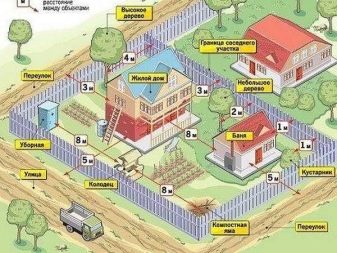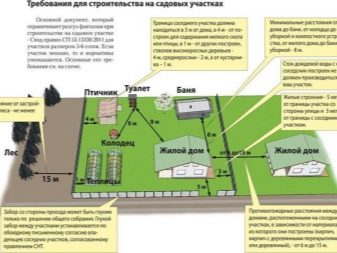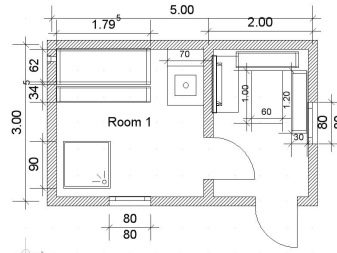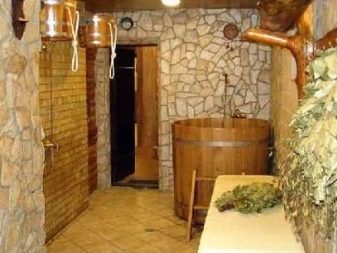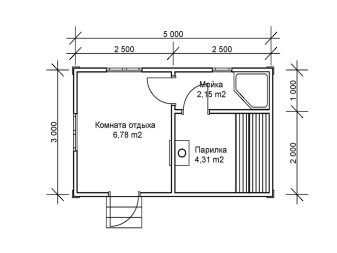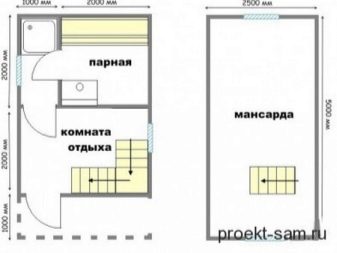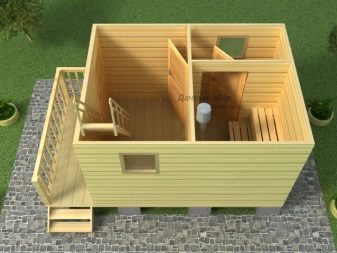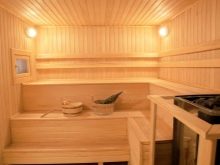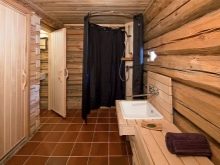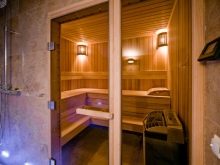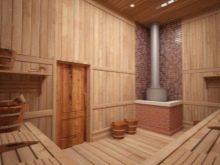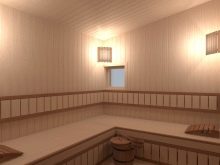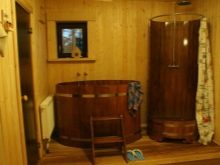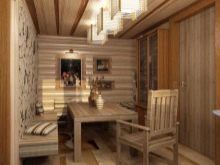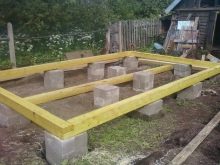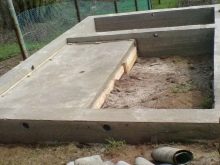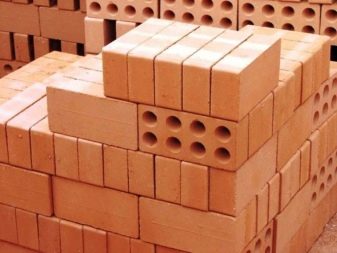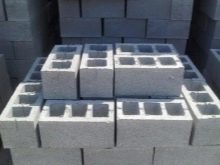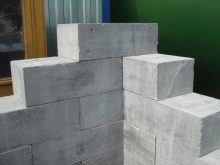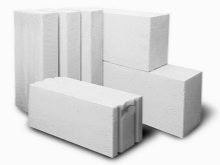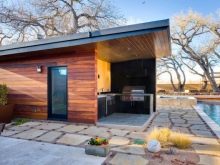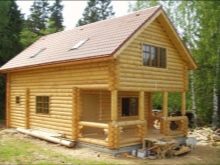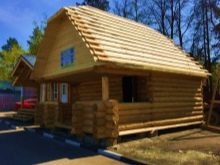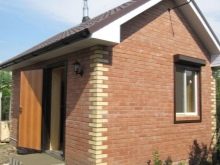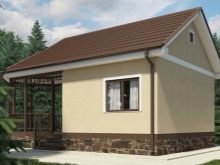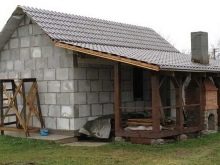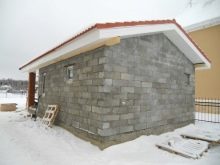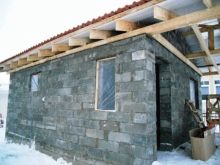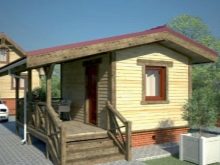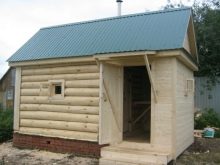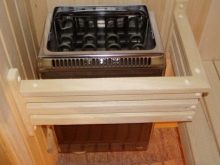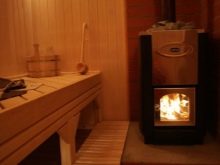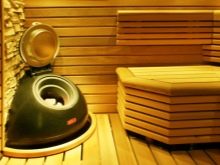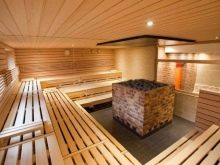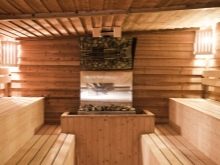Bath size 3 to 5: the subtleties of the internal layout
Bath is an integral part of many cultures, including Russian. Each person owning his own backyard, sooner or later thinks about building a bath. This is not just a tribute to the age-old tradition and a place of hygienic procedures, the bath is also a place of rest. It is worth proceeding to construction, having carefully planned everything, because in most cases the building should be compact.
Where to begin?
You should start by choosing a place for a bath. The size of 3x5 m is considered the most popular, which can fit even in a small area. It is worth taking a responsible approach to choosing a place for a bath, taking into account personal, aesthetic preferences, various norms and rules (including fire and sanitary facilities). The image below shows the minimum distances between objects within the boundaries of the site.
Immediately you need to exclude the place of shallow groundwater. They are ideal for a well or well. For the construction of the house or bath they are not suitable. If your site is bordered by a reservoir, it makes sense to build a bathhouse closer to the shore, then you will not have to deal with the construction of the pool.
Which project to choose?
In the era of technology and the Internet, everyone can choose a project that fits him perfectly. In most cases, they differ only in the internal layout. The first question to decide when choosing a plan is the combined or separate placement of the steam room and the sink. Consider both options.
In the picture above you can see the layout of a 3 by 5 bath with a combined steam room and a sink. The total building area is 15 m / 2, the size of the steam room and the dressing room is 9 and 6 square meters. m
In the steam room there are:
- shower area with drainage;
- oven with hot water tank;
- bunk shelves.
Mobile benches can be added as desired. A dressing room (also known as a rest room) contains a set of tables and benches. It also includes the furnace furnace.
Two facts speak in favor of combining the steam room and the washing room:
- with a small amount of space, temperature and humidity change too drastically, which negatively affects the well-being of people;
- pores on the skin open under the influence of high temperature, in the steam room and close again from the low temperature washing; each subsequent entry forces the skin to steam again, and when these two rooms are combined, the skin does not cool down.
Now consider the option with a separate sink and steam room. A waiting room occupies 9 square meters. m, steam room is 4 square meters. m, and the sink takes 2 square meters. The size of this project is the same as the previous one (3x5 m), but there are already three rooms here. Optionally, both options can be modified by sliding the walls in one direction or another.
What else do you need in the bath?
Often in the baths you can find another room: a vestibule or hallway. Its purpose is simple, but important enough. When you exit the waiting room to the street, warm air rushes through the open door, which causes rapid cooling, and the tambour helps to avoid this. Here you can arrange a dressing room, remove outerwear, store a variety of bath utensils, dry firewood before use.The figure below shows an example of a 3 by 5 m bath with a vestibule.
Baths are not always one-story. Often, an attic is built as an additional floor, which is inferior in size to a bath. In Figure 4 you can see the stairs to the attic floor. With a bath size of 3x5 m, the attic will be no more than 2.5 m by 5 m. It can be used at your discretion. Terraces are attached to the bath, some of them have access to a reservoir (natural or artificial). It is not necessary to build a pool: you can build a wooden font or buy a plastic one.
Interior decoration and layout
When you have already decided on the project, you need to think about the interior of the bath. Steam room and sink are the main rooms of the bath. Regardless of whether you decide to place them together or separately, there must be shelves and stands (for the first room), a tray, a sink and towel holders (for the second room). The furnace should be located in the steam room, but the kindling will occur from the waiting room. In the dressing room you can arrange a table and benches, stands for shoes and hangers for outerwear.
Consider a few nuances of bath planning:
- it is better to have the front door on the south side: there are less snow drifts, the snow melts earlier;
- Do not neglect the windows: their main goal is not lighting, but airing; The ideal option for windows for steam and washing is 40x40 cm;
- window openings are located on the western side due to the fact that usually a bath is used in the afternoon, the rays of the setting sun will help save electricity;
- The vestibule is obligatory for buildings used all year round: if you take a bath in the bath only in summer, its construction becomes optional, which helps save money;
- it is better to lay out the concrete floor with ceramic tiles and put a few wooden gratings so that your feet are not cold;
- wooden flooring must be leaking to reduce moisture and ease maintenance;
- the simplest and most economical method of interior decoration bath - lining;
- do not neglect the insulation, choose breathable materials;
- for finishing inside it is better to choose deciduous trees: coniferous produce resin when heated;
- should develop a plan for ventilation of the room.
Foundation building
The foundation is the first stage of any construction.For the bath more often choose the tape or column type. The choice depends on the composition of the soil at the construction site. Clay and fine sand suggest the construction of a monolithic strip foundation, if the soil is predominantly stony with coarse sand, erect a columnar foundation. If the site has a high level of groundwater, it is better to choose a foundation on screw piles: this will be more reliable. All three types of foundation must be erected, adhering to the recommendations regarding their construction, in order to increase their strength and service life.
What to build walls from?
Materials for the construction of walls there are many. The main ones are:
- tree;
- brick;
- cinder block;
- foam block;
- aerated concrete.
Tree
A real Russian bath should be wooden (as many people think). Someone immediately buys a finished blockhouse with the installation, so as not to waste time on the project and construction. Others choose a timber or rounded log. In any case, the construction of a wooden bath should be taken responsibly. Wood is exposed to various atmospheric phenomena, has the properties of drying out and swelling.
Here, in addition to the choice of the tree itself, you need to take care of various antiseptic and fire-fighting means of impregnation.
Brick
Brick bath has several advantages.The main is the long life, as the brickwork is much thicker in relation to the wooden walls. The thermal conductivity of a brick is much higher; thermal insulation requires a more detailed approach. The brick structure looks presentable, may not require exterior trim.
Blocks
Slag stone, foam block, aerated concrete and many other materials used for construction are suitable for the construction of a bath not worse than solid wood and bricks. They have lower thermal conductivity than brick, and it takes less time to build walls.
After the walls are erected, it is necessary to take care of the heat and waterproofing to eliminate dampness, drafts and cooling of the rooms.
Roof
The roof is the final stage of building a bath. It can be made single or dual, regular or mansard type. Attic is preferable: it can be used to store bath accessories, it is better to retain heat. The rafter system is collected on the ground, installed on the walls as a finished product, or erected directly on site. The choice of lathing depends directly on the coverage.
For shingles, metal tiles and flat slate need a continuous crate,for the rest fit with a distance of up to 25 cm between the boards.
Roof insulation is carried out in the same way as wall insulation.
Heating
The furnace can be of several types: wood, electric and gas. Each of them has its advantages. The wood stove keeps heat longer, gives a unique aroma. Such designs are iron and brick. The first option can be bought or made independently, the second is better to be entrusted to a professional: because of an error in the laying, there is a high risk of suffocation. It is believed that for heating 1 square. m bath requires a minimum of 30 bricks.
Gas and electric ovens heat up much faster than wood-burning counterparts. The size of the bath 5x3 m does not give a wide field of action. However, if you wish, you can arrange the space so that it will be aesthetically attractive and functional. The internal arrangement requires no less attention: the atmosphere of comfort depends on it.
An example of the interior of the bath, see the following video.

